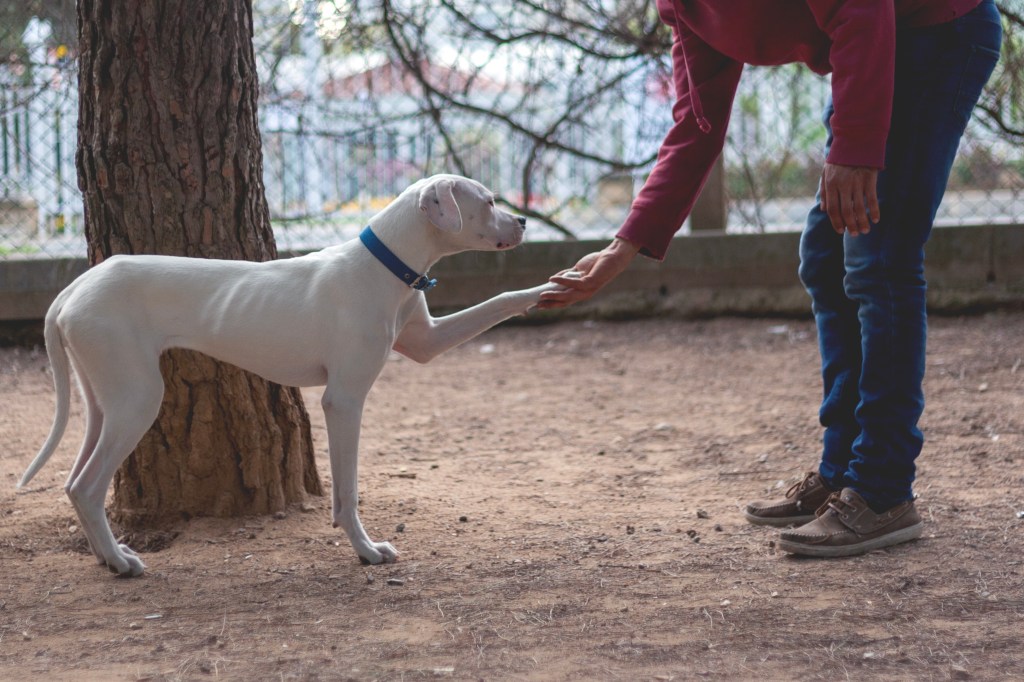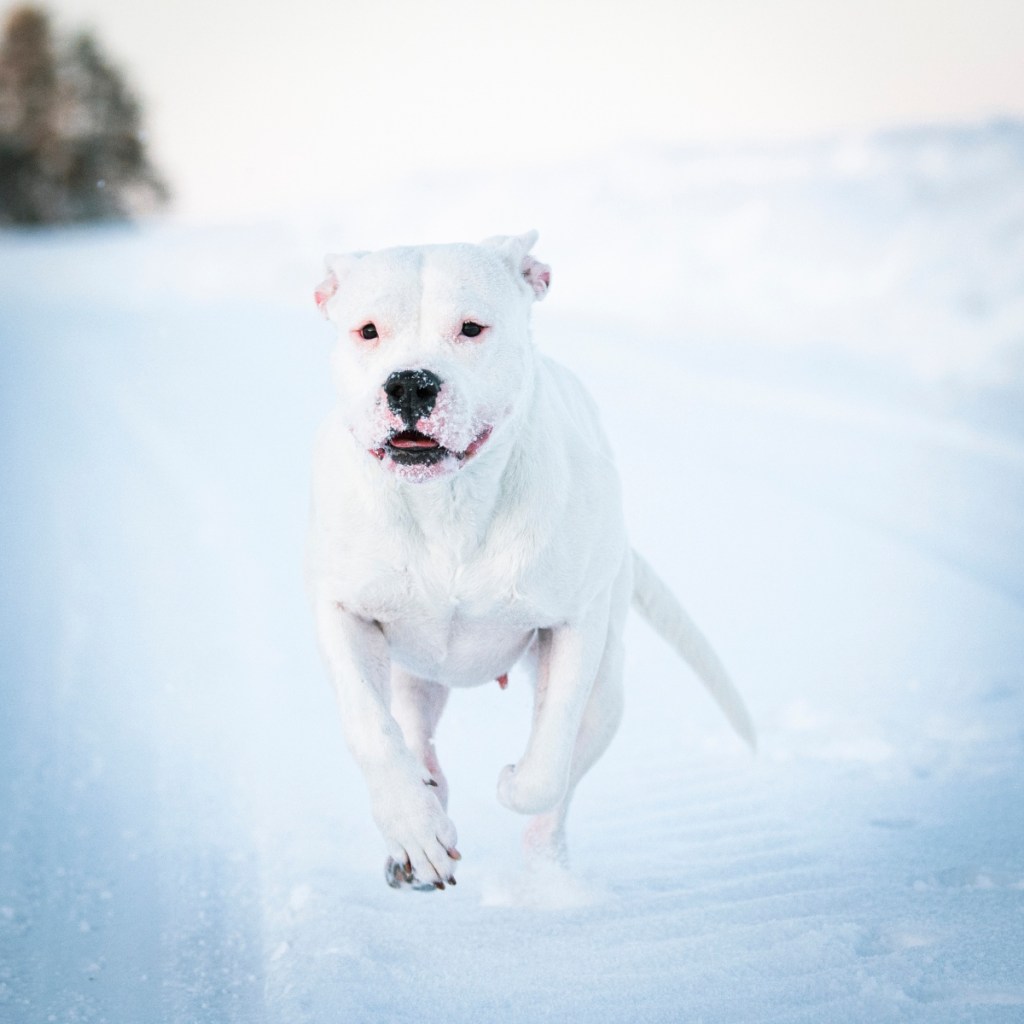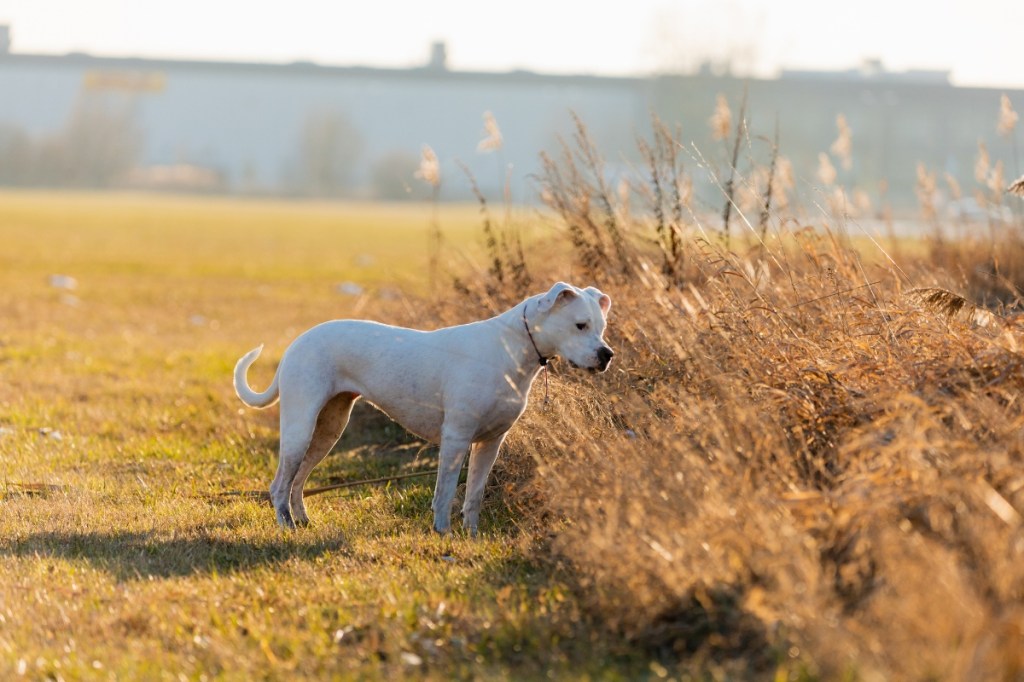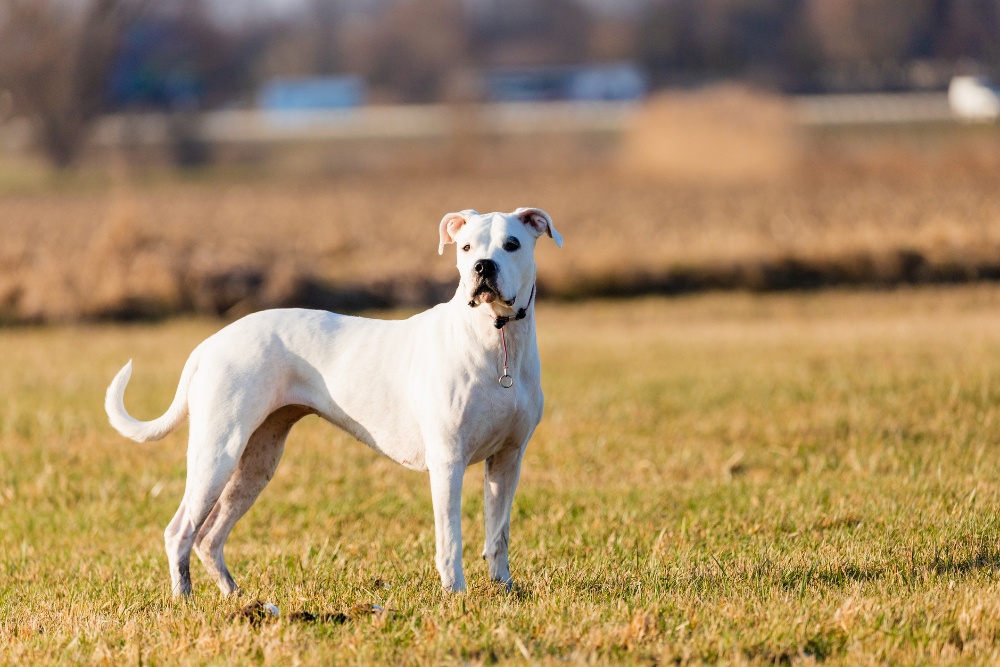Table of Contents
Introduction to Dogo Argentinos
The Dogo Argentino is an athletic and courageous dog breed, a pack-hunting dog that also makes a great family pet. Originally, Dogo Argentinos were bred to hunt puma and wild boar. These large and powerful dogs are also intelligent and agile, making them ideal candidates for police and rescue work.
To learn more about the Dogo Argentino dog breed, the Healthy Paws team created this breed guide with information about the dogs’ characteristics, temperament, health issues, and care recommendations.
Size of Dogo Argentinos
Dogo Argentinos are large dogs that weigh between 80 and 100 pounds when fully grown. Males stand 24 to 26.5 inches tall, and females are about an inch shorter. These dogs reach their adult size between 16 and 18 months. Their fastest growth occurs between seven and eight months.
Here’s a chart detailing how big you can expect your Dogo Argentino to get as the dog grows from puppyhood to adulthood. Female weights are at the low end of the range, and male weights are at the high end.
| Weight Chart | 3 months | 6 months | 9 months | 12 months |
| Female and male Dogo Argentinos | 31.5 – 34.4 lbs. | 58.9 – 63.8 lbs. | 75.6 – 83 lbs. | 83.2 – 92.6 lbs. |
Characteristics of Dogo Argentinos
Dogo Argentino characteristics that stand out include being large, muscular, strong, wary of strangers, and dedicated family companions. These dogs don’t like to be left alone for extended periods of time, and they need a good amount of exercise to stay mentally stimulated and prevent destructive behavior.
As you get to know a Dogo Argentino’s personality, here’s what you can expect based on the breed characteristics:
| Breed Characteristic | Level (High, Medium, Low) |
| Affectionate with People | Medium |
| Good with Kids | Medium |
| Good with Pets | Medium |
| Need for Exercise | High |
| Energy Level | High |
| Intelligence Level | Medium |
| Able to Be Trained | Medium |
| Amount of Barking | Low |
| Amount of Shedding | Low |
History of Dogo Argentinos
The Dogo Argentino breed originates from Cordoba, which is in the central region of the Republic of Argentina. Dr. Antonio Nores Martinez is credited with developing the breed in the 1920s by crossbreeding several purebred dogs with a Cordoba fighting dog. Martinez wished to use the dog for hunting and to go on hunting trips with him in search of large game, including boar and mountain lion. He worked with his brother to promote the dog, write the first breed standard, and demonstrate its hunting and fighting capabilities.
The Argentine Kennel Club recognized the breed in 1964, but the American Kennel Club did not recognize the Dogo Argentino as a breed until 2020.

Dogo Argentino Standard Information
The breed standard for the Dogo Argentino describes this dog as full of power and energy, alert, intelligent, and having a completely white coat. The dog has a large mouth and powerful bite to aid its hunting capabilities, yet the overall appearance of the dog is balanced, and the gait is efficient.
Here is an overview of the breed standard information for Dogo Argentinos:
Head:
- Powerful and balanced
- Medium-sized, almond-shaped eyes
- Alert and intelligent expression
- Ears are usually cropped and erect or semi-erect
- Muzzle is longer than deep and strong
- Nose is totally black with large nostrils
- Jaw is strong and powerful from the bottom jaw angulation
Neck, Topline, Body:
- Strong, thick, arched, and elegant neck
- Thick and wrinkled neck skin
- Pronounced withers
- Slightly off-square body
- Deep thorax
- Short and muscular loins
- Broad and muscular croup
Forequarters:
- Legs are vertical and straight
- Shoulders are laid-back and muscularly developed
- Upper arm is the same length as the shoulder
- Front feet have tight-fitting toes and thick, black pads
- Dewclaws can be removed
Hindquarters:
- Hindquarters are broad, with muscular thighs
- Strong hocks that are perpendicular to the ground
- Rear feet are slightly smaller than the front feet
- No dewclaws
Coat:
- Coat is straight, short, and uniform
- Average length is ½ to ¾ inches
Color:
- The color is entirely white
- Black or dark spots may exist on the skull or one eye or ear
- No more than one spot on the head
- Spot size may not exceed 10 percent of the head
Gait:
- Firm and agile
- Harmonious and balanced
- Level-backed and ground-covering stride
- Powerful drive from the rear
Caring for Dogo Argentinos
Dogo Argentinos are not ideal apartment dogs and are also not the best dogs for first-time pet parents. They do better in warm than cold weather and are moderately trainable. However, these dogs need strong, patient family members dedicated to early socialization.
Here are some general tips for taking the best care of a Dogo Argentino.
Best Living Environments:
- Houses with yards – no apartments
- Best as the only pet in the household
- Should live with active family members committed to exercise
Type of Exercise:
- At least an hour of daily exercise
- Several walks per day
- Swimming
- Running around a yard
- Hiking
- Chasing flying discs
- Retrieving balls
Mental Enrichment:
- Hide-and-seek games
- Chasing balls rolled along a floor
- Obedience and agility training
Training Strategies:
- Work to handle the strong prey drive with small animals
- Socialize from early puppyhood
- Use positive reinforcements, not harsh corrections
Grooming Tips:
- Groom weekly
- Bathe only occasionally
- Trim nails regularly
- Check ears for wax and debris
- Brush teeth daily

Common Health Problems of Dogo Argentinos
The average life expectancy of a Dogo Argentino is 9 to 15 years. Fortunately, these dogs are generally healthy with few genetic health issues. However, the national breed club recommends the following health test for the breed: hip evaluation, BAER (Brainstem Audio Evoked Response) testing, and a cardiac exam. Also, this breed is more prone to deafness than other dog breeds.
These are some of the most common health issues that arise with Dogo Argentinos:
- Glaucoma
- Deafness
- Hypothyroidism
- Laryngeal paralysis
- Hip dysplasia
Diet and Nutrition for Dogo Argentinos
Dogo Argentinos are large dogs that require substantial food daily to fuel their energetic lifestyles. Puppies need three meals per day, but you can drop the frequency to twice daily once your Dogo Argentino reaches adulthood.
Puppies have specific nutritional requirements, such as higher amounts of fat and protein, to promote healthy growth and development. Select a puppy food that has an AAFCO (Association of American Feed Control Officials) label stating that the food is formulated for growth and reproduction. If you have an adult Dogo Argentino, select a food with an AAFCO label stating that the food is formulated for adult maintenance.
A Dogo Argentino puppy between one and three months needs approximately 2 to 3 ¾ cups of dry dog food daily, while a 12-month-old Dogo Argentino needs 4 to 5 cups daily. Talk with your veterinarian about the right portion size for your specific pup. Wet and dry food have the same nutritional value, so the type you feed often comes down to personal preference; your pup may prefer one over the other, or want both in combination.
Where to Adopt or Purchase Dogo Argentinos
If you are looking for a pure Dogo Argentino, the Dogo Argentino Club of America is an excellent place to start. This national breed club provides information and resources about this type of dog. The AKC Marketplace helps people find Dogo Argentino puppies from reputable breeders. Depending on the dog’s bloodline, you can expect to pay $2,000 or $3,000 for a pure Dogo Argentino from a breeder.
You can also adopt a Dogo Argentino in need of a loving home from a rescue organization, such as DC Dogos, Inc., a nonprofit dedicated to the breed and finding adoptive homes for the dogs. You can also contact DARN (Dogo Argentino Rescue Network) and La Historia Dogo Argentino to learn more about volunteering, rescuing, rehabilitating, adopting, transporting, fostering, and donating money to help Dogo Argentinos in need of support.

Related Breeds
Before deciding on a specific dog breed to bring into your life, you might also want to learn about similar and related breeds to make the best decision for your household. Here are some breeds that may interest you if you love Dogo Argentinos:
- Cane corso
- Presa canario
- American Staffordshire terrier
- Great Pyrenees
- Irish wolfhound
- Great Dane
- Boxer
- Spanish mastiff
- Dogue de Bordeaux
Pet Insurance for Dogo Argentinos
Pet insurance is a good idea for Dogo Argentinos because their active lifestyle often involves hunting and chasing prey. If your Dogo Argentino becomes injured or gets sick unexpectedly, a Healthy Paws pet insurance plan can help you pay the veterinary bills without worrying about whether you can afford recommended treatments. The easy-to-understand insurance plan covers accidents, illnesses, cancer, emergency care, genetic and hereditary conditions, breed-specific conditions, and alternative care.
We offer flexible premium and deductible options for Dogo Argentinos and have enrolled over 560,000 pets with no enrollment or administrative fees. Check your insurance rate today and take the next important step in caring for your Dogo Argentino in the best way possible.









